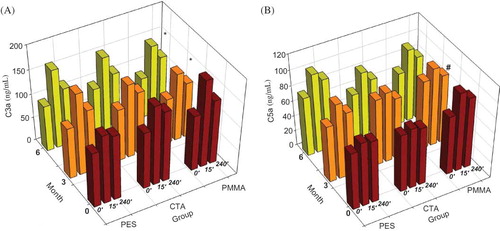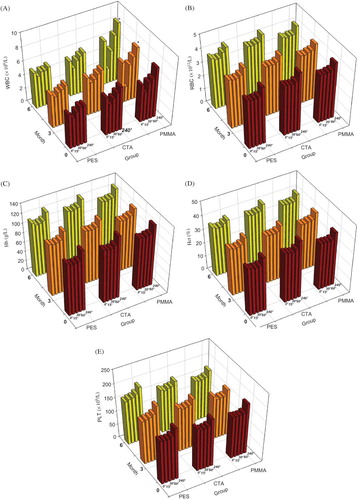Figures & data
Table 1. Dialyzer characteristics.
Table 2. Patients’ characteristics on month 0.
Table 3. Reduction ratios (%) of several solutes among different groups.
Table 4. Blood levels of inflammation factors.
Table 5. Blood levels of complements.
Figure 1. Changes of blood levels on complement (C3a) (A); on complement (C5a) (B). The maintenance hemodialysis patients all were treated by polysulfone membrane dialyzers on month 0. They were divided into three different groups randomly equally according to different membranes as group PES, group CTA, and group PMMA. PES, ployethersulfone; CTA, cellulose triacetate; PMMA, polymethylmethacrylate. The number of patients in each group was 20. The patients were followed-up for 6 months. The blood levels of complement 3a (C3a) and 5a (C5a) were detected on months 0, 3, and 6. They were detected at 0, 15, and 240 min in one session on each month. The details of data are listed in Table 5.
Notes: Blood levels of both C3a and C5a increased significantly at 15 min and decreased gradually at 240 min in most sessions, except for C5a levels on month 0. The pattern on changes of C3a and C5a in three groups was similar.
*Denotes However, the range of C3a levels in group PMMA were declined significantly when the dialyzers changed from PS to PMMA membrane, both on month 3 and on month 6 (p < 0.05).
**Denotes The changes of C5a levels were significantly different between group CTA and PMMA on month 3 (p < 0.05).

Table 6. Blood cells’ detection.
Figure 2. Blood cell detection of (A) white blood cell count; (B) red blood cell count; (C) hemoglobin; (D) hematocrit; (E) platelet count.The maintenance hemodialysis patients all were treated by polysulfone membrane dialyzers on month 0. They were divided into three different groups randomly according to different membranes as group PES, group CTA, and group PMMA. PES, ployethersulfone; CTA, cellulose triacetate; PMMA, polymethylmethacrylate. The number of patients in each group was 20. The patients were followed-up for 6 months. White blood cell (WBC) count, red blood cell (RBC) count, hemoglobin (Hb), hematocrit (Hct), platelet counts (PLT) in peripheral circulation were detected on months 0, 3, and 6. The above parameters were detected at 0, 15, 30, 60, and 240 min in one session on each month. The WBC decreased significantly at 15 min and increased gradually at 30, 60, 240 min in each session. The pattern on changes of WBC in three groups was similar. Notes: *However, the WBC declined much significantly at 15 min and raised up much more quickly at 30, 60, 240 min when the patients were treated by using PMMA membrane than other membranes (p < 0.05). The other parameters also first decreased at 15 min, and then increased gradually during residual period in one dialysis session. There were no statistical differences in RBC, Hb, Hct, and PLT neither among each group nor among the months 0, 3, and 6 (p > 0.05).

Table 7. Comparison of solute removal markers and biocompatible markers among four groups.